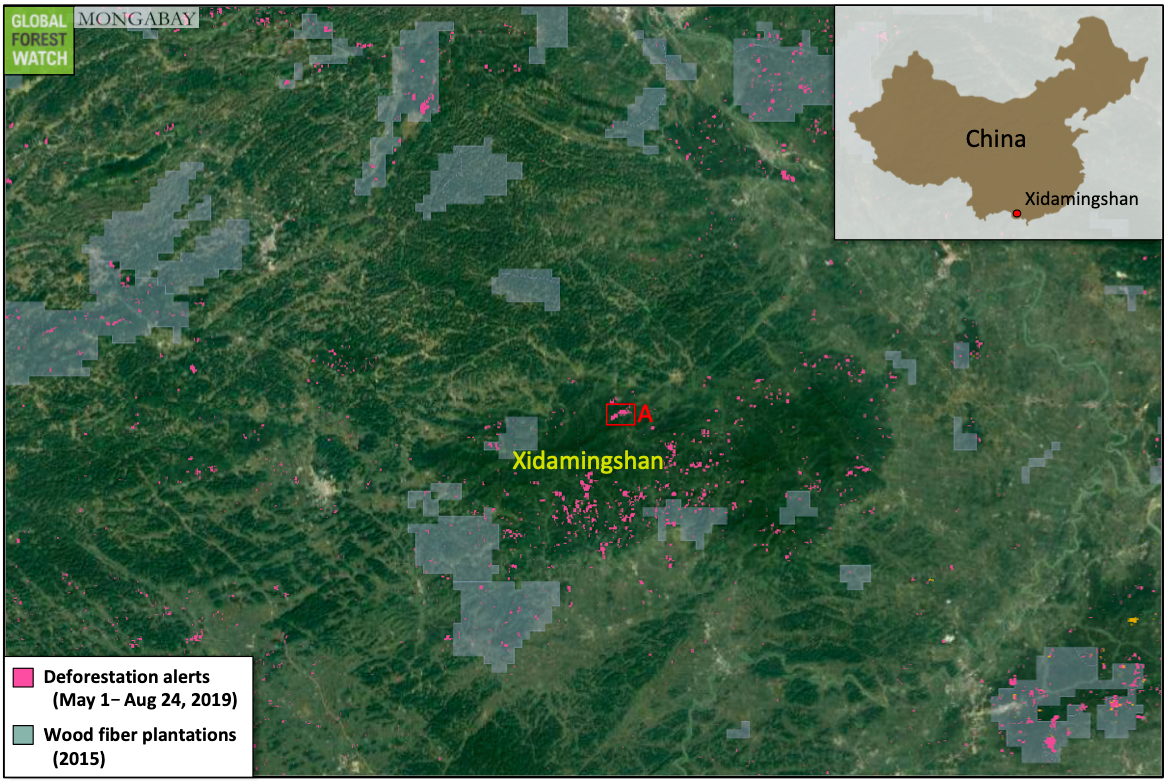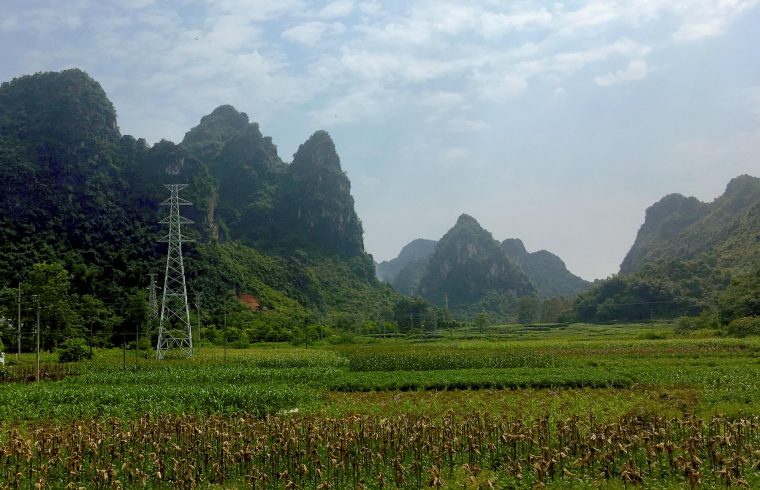- Forests in South China have been increasingly replaced by monoculture ecalyptus plantations grown for wood fiber for the pulp and paper industry. Even forests under official protection haven’t been spared. Xidamingshan Forest Reserve is one of these, losing so much of its native forest over the past decade that it was delisted by the World Database of Protected Areas in 2018.
- Central government-led environmental inspections in 2016 found that the Guangxi region lost 6.9 percent of its nature reserve areas over a five year period between 2011 and 2015, with the loss primarily due to unclear borders and the ensuing environmental damage from economic activities such as plantation agriculture and mining.
- The Guangxi government set about trying to determine the borders of the Xidamingshan Nature Reserve in 2016, with the final determination coming on Jan. 31, 2019. However, where those borders will actually be depends on the outcomes of negotiations between Guangxi and local governments, and their implementation is at the mercy of a protracted bureaucratic process.
- Meanwhile, forests continue to be lost at a fast pace, with satellite data showing large areas of tree cover loss in 2019.
The low rolling hills west of Nanning are almost entirely covered with eucalyptus plantations. The airy trees, like large arrows stuck into the earth, seem to go on forever, snaking over ridges and up steep slopes, the forest floor below them nearly devoid of life.
The karst outcroppings the region is famous for jut irregularly from the hilly landscape. While the occasional formation is cut in half for its limestone destined to become cement, most are still covered with natural vegetation. It’s a different story in the lower flatlands, which are dominated by vast sugar cane and banana plantations.
These are the scenes along the two-hour drive west of the capital of the Guangxi-Zhuang autonomous region, a province in South China bordering Vietnam on the north. Within a string of mountains at a higher elevation in this area and ringed with karst, is a major watershed called Xidamingshan Nature Reserve, or West Daming Mountain.

The area was designated a nature reserve in 1982 along with 32 other watershed forest areas around China, and had been included in the World Database of Protected Areas (WDPA) until 2018 when it lost that status due to concerns that much of the reserve’s natual habitat had been replaced by tree plantations. While it’s still considered a protected watershed nature reserve in China, its borders were never fully established. Movement by the government to set borders is ongoing, but the process is slow and further hindered by conflicts between nearby villages and Guangxi government about where they should go.
A mid-August visit by Mongabay to the reserve area confirms that tree plantations, almost entirely eucalyptus, have been displacing natural forest in and around the reserve over the past decade. Eucalyptus plantations have spread across the region due to their attractiveness as a cash crop for farmers and villagers. Local government documents and interviews with village officials also confirm that this has become a problem.
“It is not a pretty picture in China,” said macroecology researcher Alice Hughes during an Aug. 20 interview with Mongabay. Hughes is affiliated with the Chinese Academy of Sciences attached to the Xishuangbanna Tropical Botanical Garden in South China’s Yunnan province, and has been studying the region’s ecology for the last ten years.
“The number of deforestation alerts have been fairly consistent,” Hughes said. “The rate of deforestation is still very, very significant. When they build new dams, these areas can just be de-protected like that. So even protected areas don’t have strong protection status.”


Shrinking reserve, shrinking watershed
At Biliu village, which lies just south of Xidamingshan Nature Reserve, village committee official Xu Yinghai explained that villagers have been planting eucalyptus there for the past decade. What areas will be protected is still unclear.
“I’ve heard they have plans to halt the plantations so the area can recover but I haven’t seen any official statements yet,” Xu said on Aug. 15. “Eucalyptus trees are very ubiquitous here, so I don’t know how they are actually going to do it.”

While he said he had not noticed any major biodiversity changes – he mentioned that wild boar are still in the area – he said the eucalyptus plantations have affected water resources in what is supposedly a protected watershed.
“The trees are certainly not good for the environment,” Xu said. “They turned the water here black, and once you plant these trees, it will be very hard for other crops or plants nearby to survive.”
The Xidamingshan Management Bureau has given the nearby town of Nalong specific mandates, Xu said, which has stopped locals from cutting down native trees there. “The permits are only for cutting down eucalyptus trees [in Nalong now],” he said.
“Eucalyptus is bad news,” Hughes said. “It is allelopathic so it is difficult for other things to grow under it because it basically makes the soil toxic, and then it has huge water consumption. So the footprint of it can be much wider than the plantation itself. It is an ecological wasteland, basically.”
Shangqin village lies at the end of a winding mountain road and, judging by a map of the region, appears to be inside the northern portion of the reserve. However, a village official said this is not the case.
“The village, as far as I know, is not included in the reserve at the moment,” said the official, who wished to remain anonymous, “but some parts of the watershed forest, which is the area surrounding the reservoir [near the village] were leased to investors and transformed into plantations, some of which were eucalyptus.”
Like Xu, the Shangqin village official had yet to receive documents about where the borders of the reserve will be.
“Expansion of the eucalyptus plantations has been stopped and now villagers can only harvest what they planted,” the official said. “They usually leave the roots when they cut down the trees so they can grow back and be harvested again.”
Before the eucalyptus trees were planted about 10 to 15 years ago, the forests here were mostly natural forests, and only a small portion of the mountains were used to plant commercial crops like star anise trees and fruit trees, he said.
“[Eucalyptus is] a good and fast way of making money,” the official said. “You see, eucalyptus trees grow very fast, and you can harvest them every five or six years, and for each mu [Chinese acre] you can make about 8,000 yuan, which is a lot more beneficial than planting other trees.”
There are 15 mu in one hectare, which means a profit of around 120,000 yuan ($17,000) per hectare in this area.
According to the village official, ecalyptus wood is harvested and transported to processing factories nearby, made into wood chips and planks, and then shipped elsewhere. Mongabay stopped by one such processing site in the valley along the main highway north of Shangqin, but was unable to get much information from the workers there about the eventual destination for the wood and wood chips.
“It goes for wood pulp and paper and a whole suite of things,” Hughes said of the eucalyptus wood.

The Shangqin official also said that water resources have decreased in the area due to eucalyptus plantations.
“They consume probably more water than any other species and are not very good at retaining water, which is different that the coniferous trees, which were the main types of trees here before,” he said.
Disputes over eucalyptus plantations and their water use has sparked dispute in parts of Guangxi, including a recent lawsuit that could turn into a landmark case, according to a recent report by China-based media outlet Sixth Tone. Li You, the report’s author, told Mongabay there is still no verdict and the villagers are awaiting a third party environmental impact assessment that could determine whether or not the court decides in their favor.
Government plans for Xidamingshan
The Guangxi government set about trying to determine the borders of the Xidamingshan Nature Reserve in 2016, with the final determination coming on Jan. 31, 2019. However, where those borders will actually be depends on the outcomes of negotiations between Guangxi and local governments.
It also established the Xidamingshan Management Bureau to oversee the enforcement of the final borders and determine what to do with the eucalyptus planted in the reserve, a process that has not yet begun. Requests from Mongabay to visit the bureau and discuss next steps with officials were not granted.
Central government-led environmental inspections in 2016 found that Guangxi lost 6.9 percent of its nature reserve areas over a five year period between 2011 and 2015, with the loss primarily due to unclear borders and the ensuing environmental damage from economic activities such as plantation agriculture and mining.
The environmental inspectors also found that local governments had attempted to shrink the size of nature reserves as a way to make illegal activities legal.
The logging of China’s natural forests has been officially illegal since 2017 when the central government instituted logging bans nationwide. But some local governments used the “Technical Regulation on Reconstruction of Low Function Forest” as a loophole to log, even in protected areas. The regulation was updated and went into effect in 2018, with amended language about protecting forests while also improving their quality, and appears to still be commonly used to circumvent forest protections.
According to the management bureau’s documentation, the area now within the boundaries of the Xidamingshan reserve holds 49,000 hectares of forest, with 63.2 percent being natural forest and 21.9 percent commercially planted, and the remaining 14.9 percent not classified.
The area is a “vital reserve for northern temperate rainforest and important for water conservation” and habitat for imperiled species such as François’s langur (Trachypithecus francoisi; listed as endangered on the IUCN Red List), the oriental pied hornbill (Anthracoceros albirostris; all but extinct in China), the large tree species Parashorea chinensis (endangered), and Tsong’s tree (Magnolia odora; vulnerable).

The bureau is trying to determine what to do with the eucalyptus trees remaining in the nature reserve, according to documentation. No decision has been made for how to restore the original habitat and compensate those who planted the trees, though the bureau states it is working on establishing a transition period. Currently “existing eucalyptus plantations can be harvested” but efforts will be made “to restore the biodiversity of the forests,” the bureau documentation states.
No data were available on how much nature reserve area has been lost specifically in Guangxi since 2015. But according to Chen Shaoxiong, head of the China Eucalypt Research Center in neighboring Guangdong province, eucalyptus plantations covered 5.47 million hectares (13.5 million acres) across South China in March 2019 – an area nearly the size of the U.S. state of West Virginia. That figure represents a marked increase over the estimated 4.54 million hectares of eucalypt plantations in 2015 and 3.68 million hectares in 2010.
“It is very hard to say the value, as the value depends on the rotation, location and management level,” Chen said in an e-mail. “But usually the value [ranges] from 50,000-80,000 RMB [per hectare] at the age of 6 years.”
That amounts to $7,000 to $11,300 for each hectare of eucalytus cultivation, which is lower than the $17,000 per hectare value the Shangqin village official gave Mongabay. Still, with the disposable income for rural citizens in China estimated to be around 14,600 yuan ($2,000) in 2018, even the low end of the spectrum means a eucalyptus plantation could become a sizeable investment towards a house, a vehicle or a child’s education.
Finding better ecological definitions
While groups like the Eucalypt Research Center claim eucalyptus trees are beneficial to the environment because they prevent erosion and help sequester carbon, studies increasingly show that monoculture tree plantations are often biodiversity deserts and species rich forests have a much greater carbon sequestration value.
Under China’s Grain-For-Green program, farmers in areas with low yields or sloped properties have been encouraged to reforest their land in the hopes of preventing flooding, erosion and landslides. However, followup research revealed that the majority of “reforestation” efforts through this program has been monoculture planting more akin to plantations than natural forest, meaning a major opportunity has been missed for increasing biodiversity and forest resilience.
Groups such as the Beijing-based China Biodiversity Conservation and Green Development Foundation have been floating proposals for China to change language in its constitution that supports the planting of trees instead to supporting biodiversity, though bureaucratic hurdles mean changes like that could take years to materialize.
“We need to develop targets that are ecologically informed,” Hughes said. “It is not just afforestation [which is the planting of trees in areas not previously forested], it is restoration, and restoration has an ecological component.”

There are some considerations of pushing forward a National Biodiversity Law. However, this has not gotten to the point of being reviewed yet by the National People’s Congress or any ministries that would need to be involved, and would also likely take several years for the process to develop.
As China will host the 15th meeting of the Conference of the Parties (COP 15) on the Convention on Biological Diversity (CBD) in Kunming in the latter half of 2020, pushing forward more biodiversity-centered policies is on the agendas of many of the country’s environmental groups at the moment.
With President Xi Jinping’s ideas of creating an “ecological civilization” now enshrined in the country’s constitution, these proposals stand to gain traction. But how deeply and broadly environmental protections will be applied when weighed against economic interests is still a major question for conservationists.
“Ultimately, for fulfilling these ideas for ecological civilization and ecological redlines, unless we have more explicit definitions of what constitutes ecologically viable forest, then we will continue to use perverse incentives to fund the loss of native forests,” Hughes said.
While China has been lauded recently for helping increase global greening through reforestation efforts, a large part of that appears to be single species replanting and monoculture tree plantations, some of which is coming at the cost of real forests. Southern China is feeling the brunt of the country’s deforestation, according to Hughes.
“In China most of the [forest] protection goes along with the protection of big animals, the pandas, the tigers, the snow leopards,” she said. “So even with China’s new conservation red line policies, it is only built around the priority protected species and a lot of those are not tropical.
“That means all of the protection is going toward the north. The south is proportionally underprotected.”
*Additional reporting and research assistance from Zhong Yunfan.
Banner image: Eucalyptus trees tower over natural forest. Image by Michael Standaert for Mongabay.
Editor’s note: This story was powered by Places to Watch, a Global Forest Watch (GFW) initiative designed to quickly identify concerning forest loss around the world and catalyze further investigation of these areas. Places to Watch draws on a combination of near-real-time satellite data, automated algorithms and field intelligence to identify new areas on a monthly basis. In partnership with Mongabay, GFW is supporting data-driven journalism by providing data and maps generated by Places to Watch. Mongabay maintains complete editorial independence over the stories reported using this data.
Feedback: Use this form to send a message to the editor of this post. If you want to post a public comment, you can do that at the bottom of the page.












